UK Business Law Analysis: Contract, Tort, and Company Law Report
VerifiedAdded on 2023/01/16
|13
|3958
|40
Report
AI Summary
This report delves into the intricacies of UK business law, examining key areas such as contract law, tort law, and company law. The report begins with an introduction to business law, defining its scope and relevance. The main body is divided into three parts, each dedicated to a specific area of law. Part 1 focuses on contract law, analyzing cases related to the formation and enforceability of contracts, including issues of consideration and breach of contract. Part 2 shifts to tort law, exploring concepts like negligence and liability, using a case study involving a customer's injury on bank premises. Part 3, which is not fully present in the provided text, would presumably address company law. The report concludes by summarizing the key findings and emphasizing the importance of understanding business law for managers. The report utilizes the IARC method (Issue, Rule, Application, Conclusion) to analyze the case laws and provide a structured understanding of the legal principles involved.
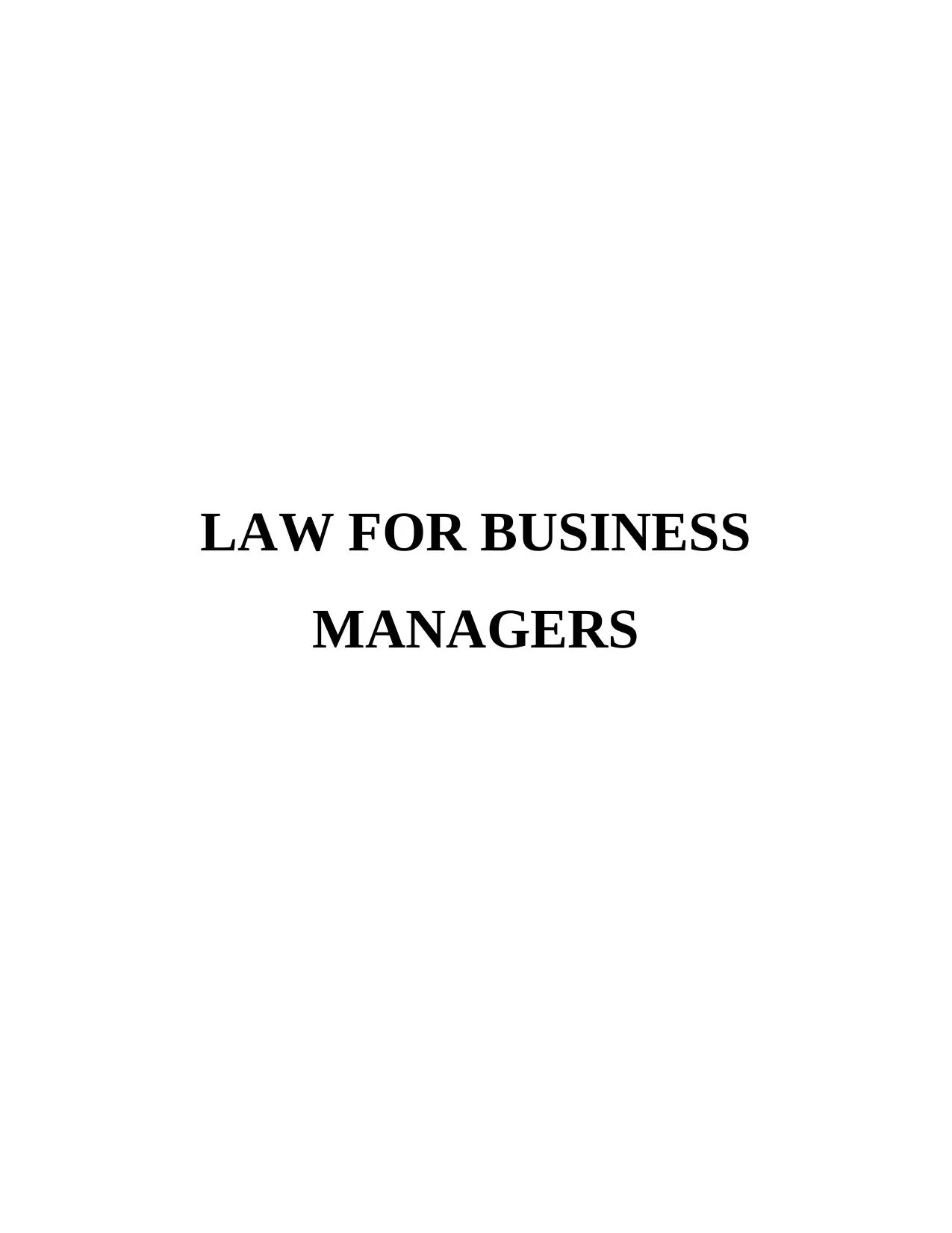
LAW FOR BUSINESS
MANAGERS
MANAGERS
Secure Best Marks with AI Grader
Need help grading? Try our AI Grader for instant feedback on your assignments.
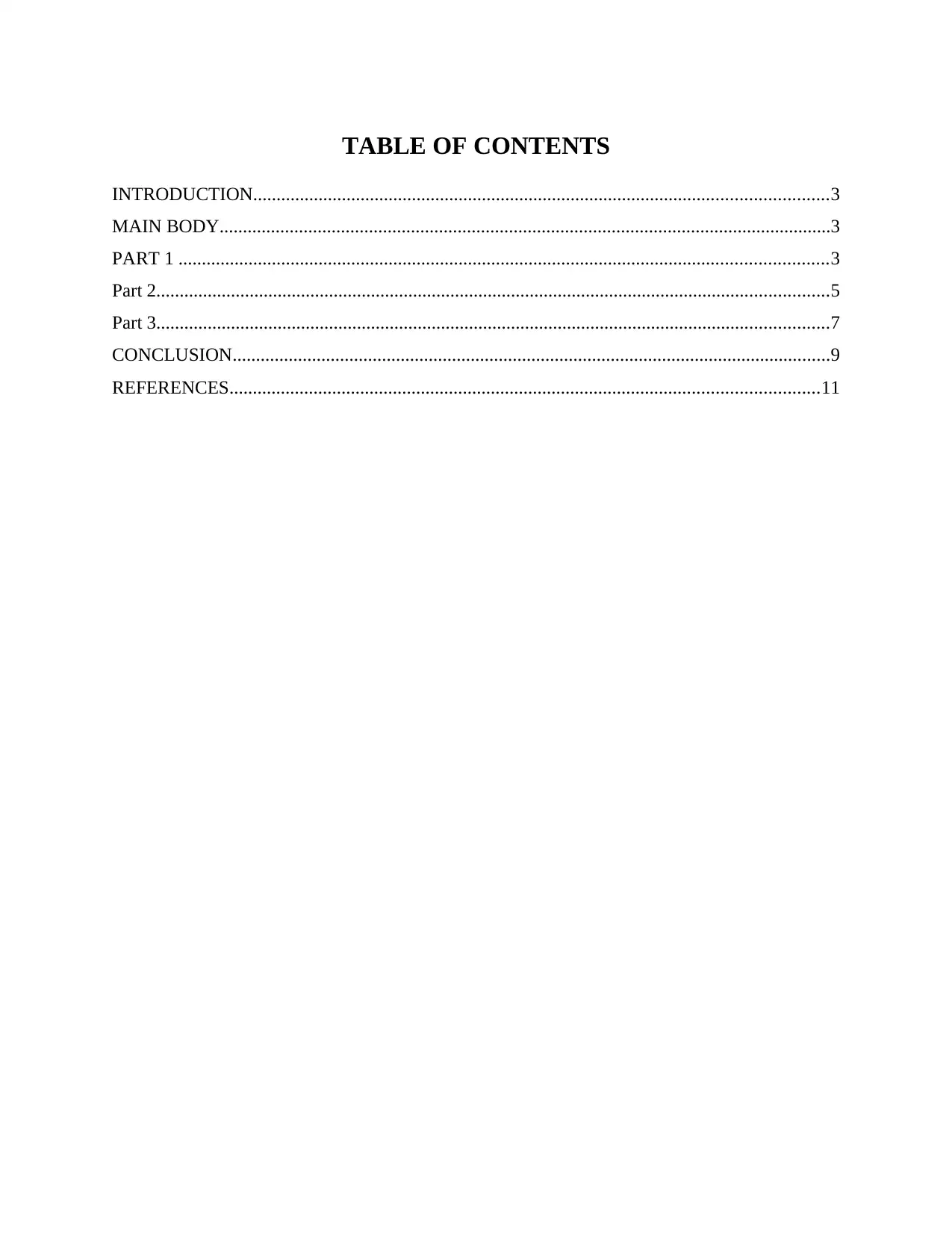
TABLE OF CONTENTS
INTRODUCTION...........................................................................................................................3
MAIN BODY...................................................................................................................................3
PART 1 ...........................................................................................................................................3
Part 2................................................................................................................................................5
Part 3................................................................................................................................................7
CONCLUSION................................................................................................................................9
REFERENCES..............................................................................................................................11
INTRODUCTION...........................................................................................................................3
MAIN BODY...................................................................................................................................3
PART 1 ...........................................................................................................................................3
Part 2................................................................................................................................................5
Part 3................................................................................................................................................7
CONCLUSION................................................................................................................................9
REFERENCES..............................................................................................................................11
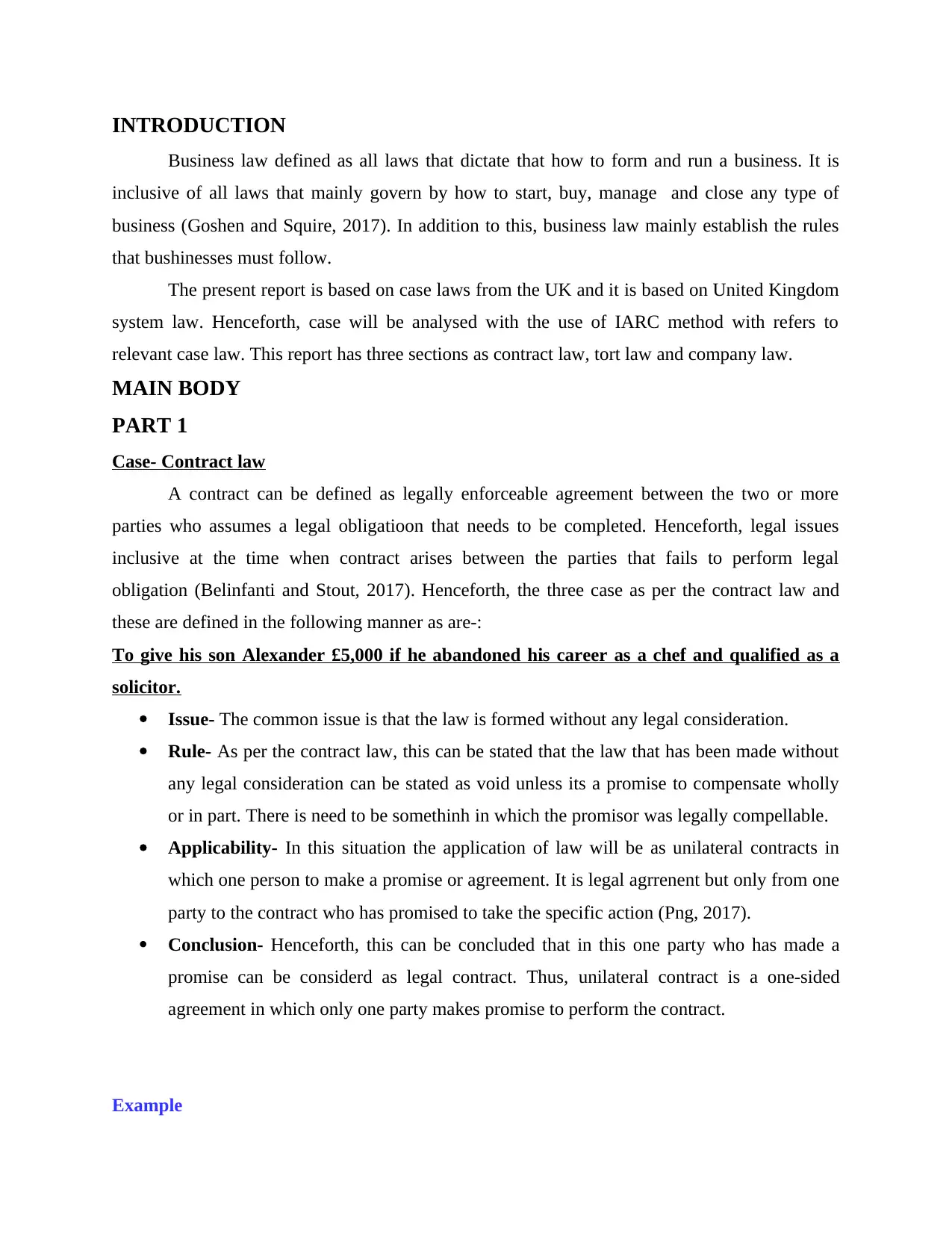
INTRODUCTION
Business law defined as all laws that dictate that how to form and run a business. It is
inclusive of all laws that mainly govern by how to start, buy, manage and close any type of
business (Goshen and Squire, 2017). In addition to this, business law mainly establish the rules
that bushinesses must follow.
The present report is based on case laws from the UK and it is based on United Kingdom
system law. Henceforth, case will be analysed with the use of IARC method with refers to
relevant case law. This report has three sections as contract law, tort law and company law.
MAIN BODY
PART 1
Case- Contract law
A contract can be defined as legally enforceable agreement between the two or more
parties who assumes a legal obligatioon that needs to be completed. Henceforth, legal issues
inclusive at the time when contract arises between the parties that fails to perform legal
obligation (Belinfanti and Stout, 2017). Henceforth, the three case as per the contract law and
these are defined in the following manner as are-:
To give his son Alexander £5,000 if he abandoned his career as a chef and qualified as a
solicitor.
Issue- The common issue is that the law is formed without any legal consideration.
Rule- As per the contract law, this can be stated that the law that has been made without
any legal consideration can be stated as void unless its a promise to compensate wholly
or in part. There is need to be somethinh in which the promisor was legally compellable.
Applicability- In this situation the application of law will be as unilateral contracts in
which one person to make a promise or agreement. It is legal agrrenent but only from one
party to the contract who has promised to take the specific action (Png, 2017).
Conclusion- Henceforth, this can be concluded that in this one party who has made a
promise can be considerd as legal contract. Thus, unilateral contract is a one-sided
agreement in which only one party makes promise to perform the contract.
Example
Business law defined as all laws that dictate that how to form and run a business. It is
inclusive of all laws that mainly govern by how to start, buy, manage and close any type of
business (Goshen and Squire, 2017). In addition to this, business law mainly establish the rules
that bushinesses must follow.
The present report is based on case laws from the UK and it is based on United Kingdom
system law. Henceforth, case will be analysed with the use of IARC method with refers to
relevant case law. This report has three sections as contract law, tort law and company law.
MAIN BODY
PART 1
Case- Contract law
A contract can be defined as legally enforceable agreement between the two or more
parties who assumes a legal obligatioon that needs to be completed. Henceforth, legal issues
inclusive at the time when contract arises between the parties that fails to perform legal
obligation (Belinfanti and Stout, 2017). Henceforth, the three case as per the contract law and
these are defined in the following manner as are-:
To give his son Alexander £5,000 if he abandoned his career as a chef and qualified as a
solicitor.
Issue- The common issue is that the law is formed without any legal consideration.
Rule- As per the contract law, this can be stated that the law that has been made without
any legal consideration can be stated as void unless its a promise to compensate wholly
or in part. There is need to be somethinh in which the promisor was legally compellable.
Applicability- In this situation the application of law will be as unilateral contracts in
which one person to make a promise or agreement. It is legal agrrenent but only from one
party to the contract who has promised to take the specific action (Png, 2017).
Conclusion- Henceforth, this can be concluded that in this one party who has made a
promise can be considerd as legal contract. Thus, unilateral contract is a one-sided
agreement in which only one party makes promise to perform the contract.
Example
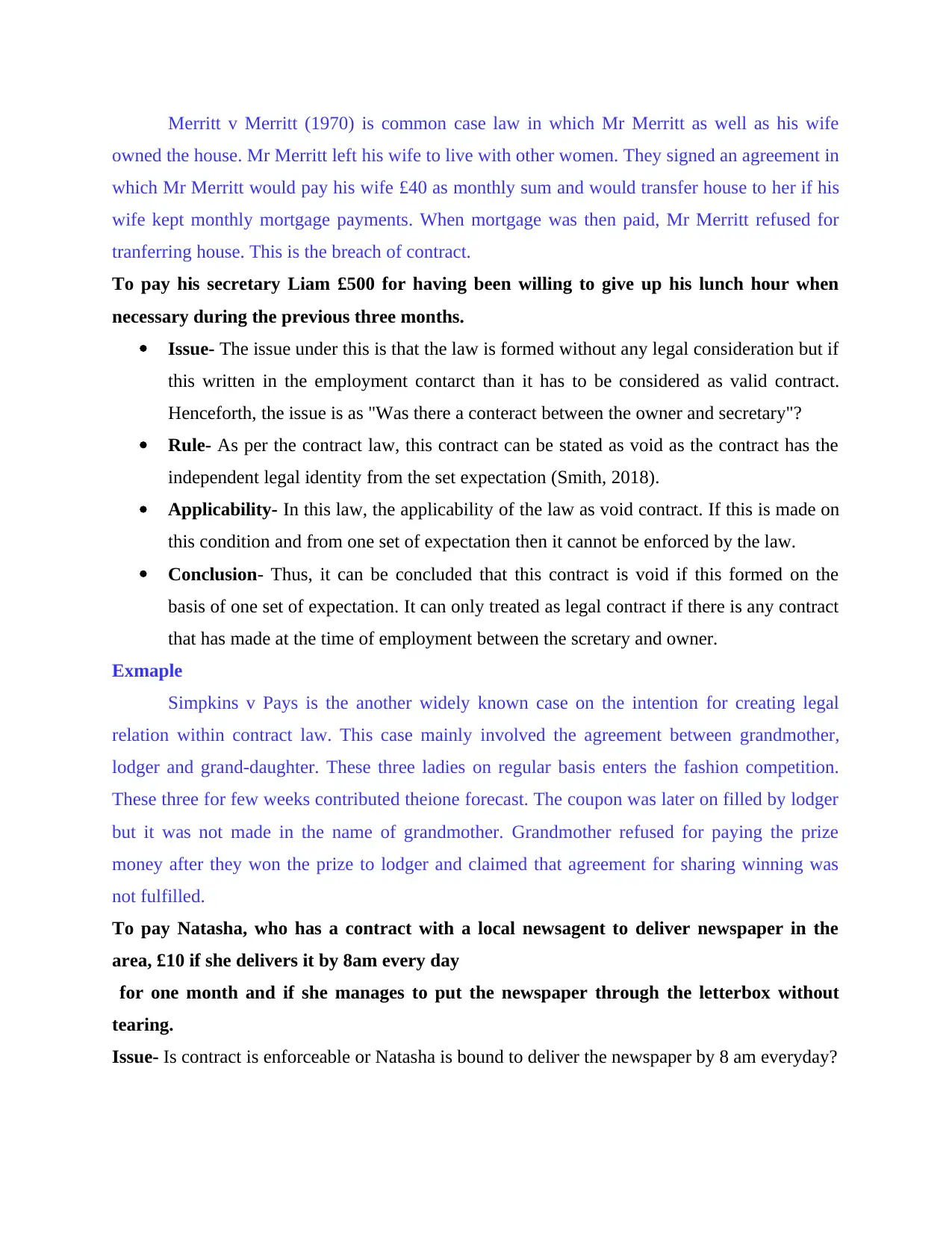
Merritt v Merritt (1970) is common case law in which Mr Merritt as well as his wife
owned the house. Mr Merritt left his wife to live with other women. They signed an agreement in
which Mr Merritt would pay his wife £40 as monthly sum and would transfer house to her if his
wife kept monthly mortgage payments. When mortgage was then paid, Mr Merritt refused for
tranferring house. This is the breach of contract.
To pay his secretary Liam £500 for having been willing to give up his lunch hour when
necessary during the previous three months.
Issue- The issue under this is that the law is formed without any legal consideration but if
this written in the employment contarct than it has to be considered as valid contract.
Henceforth, the issue is as "Was there a conteract between the owner and secretary"?
Rule- As per the contract law, this contract can be stated as void as the contract has the
independent legal identity from the set expectation (Smith, 2018).
Applicability- In this law, the applicability of the law as void contract. If this is made on
this condition and from one set of expectation then it cannot be enforced by the law.
Conclusion- Thus, it can be concluded that this contract is void if this formed on the
basis of one set of expectation. It can only treated as legal contract if there is any contract
that has made at the time of employment between the scretary and owner.
Exmaple
Simpkins v Pays is the another widely known case on the intention for creating legal
relation within contract law. This case mainly involved the agreement between grandmother,
lodger and grand-daughter. These three ladies on regular basis enters the fashion competition.
These three for few weeks contributed theione forecast. The coupon was later on filled by lodger
but it was not made in the name of grandmother. Grandmother refused for paying the prize
money after they won the prize to lodger and claimed that agreement for sharing winning was
not fulfilled.
To pay Natasha, who has a contract with a local newsagent to deliver newspaper in the
area, £10 if she delivers it by 8am every day
for one month and if she manages to put the newspaper through the letterbox without
tearing.
Issue- Is contract is enforceable or Natasha is bound to deliver the newspaper by 8 am everyday?
owned the house. Mr Merritt left his wife to live with other women. They signed an agreement in
which Mr Merritt would pay his wife £40 as monthly sum and would transfer house to her if his
wife kept monthly mortgage payments. When mortgage was then paid, Mr Merritt refused for
tranferring house. This is the breach of contract.
To pay his secretary Liam £500 for having been willing to give up his lunch hour when
necessary during the previous three months.
Issue- The issue under this is that the law is formed without any legal consideration but if
this written in the employment contarct than it has to be considered as valid contract.
Henceforth, the issue is as "Was there a conteract between the owner and secretary"?
Rule- As per the contract law, this contract can be stated as void as the contract has the
independent legal identity from the set expectation (Smith, 2018).
Applicability- In this law, the applicability of the law as void contract. If this is made on
this condition and from one set of expectation then it cannot be enforced by the law.
Conclusion- Thus, it can be concluded that this contract is void if this formed on the
basis of one set of expectation. It can only treated as legal contract if there is any contract
that has made at the time of employment between the scretary and owner.
Exmaple
Simpkins v Pays is the another widely known case on the intention for creating legal
relation within contract law. This case mainly involved the agreement between grandmother,
lodger and grand-daughter. These three ladies on regular basis enters the fashion competition.
These three for few weeks contributed theione forecast. The coupon was later on filled by lodger
but it was not made in the name of grandmother. Grandmother refused for paying the prize
money after they won the prize to lodger and claimed that agreement for sharing winning was
not fulfilled.
To pay Natasha, who has a contract with a local newsagent to deliver newspaper in the
area, £10 if she delivers it by 8am every day
for one month and if she manages to put the newspaper through the letterbox without
tearing.
Issue- Is contract is enforceable or Natasha is bound to deliver the newspaper by 8 am everyday?
Secure Best Marks with AI Grader
Need help grading? Try our AI Grader for instant feedback on your assignments.
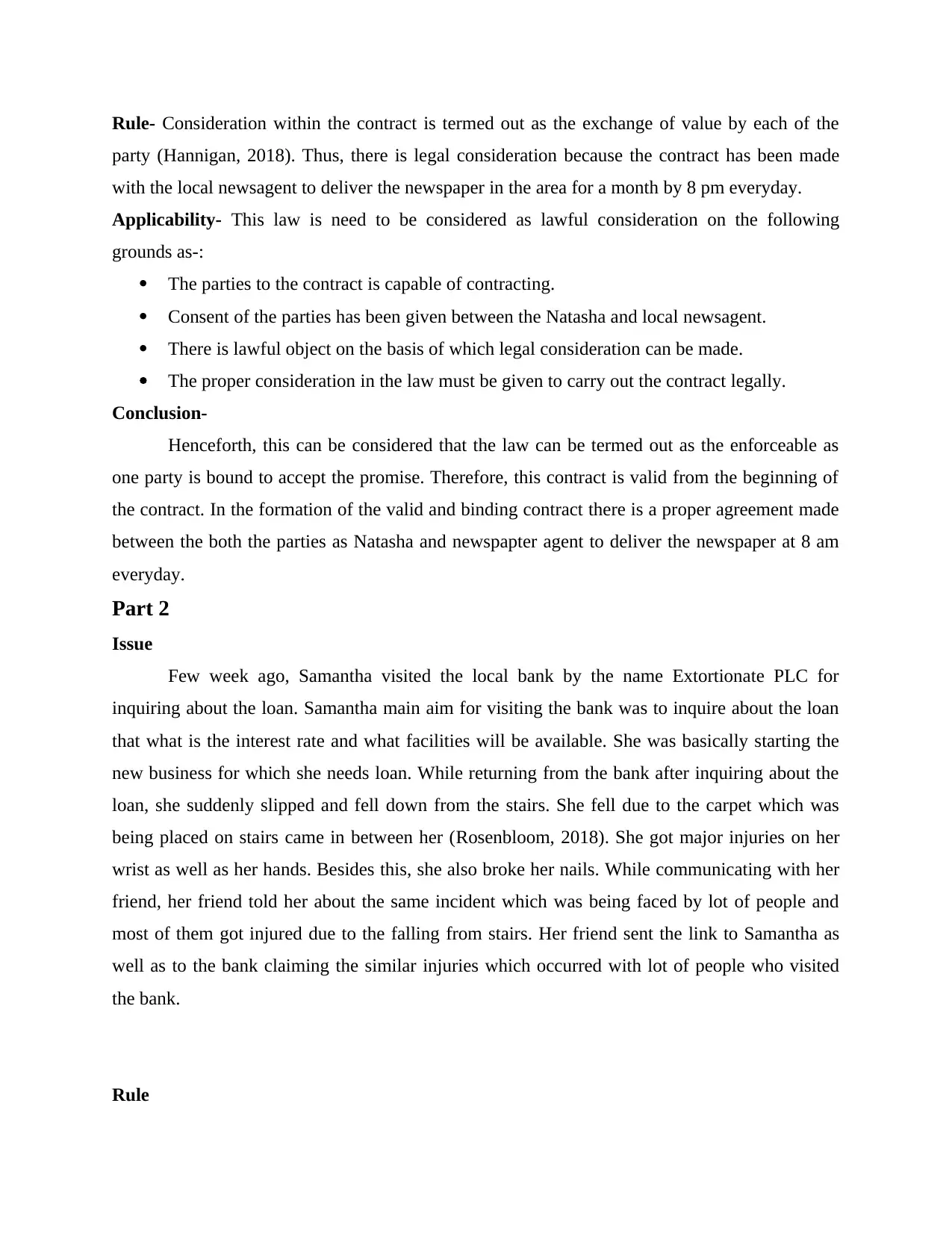
Rule- Consideration within the contract is termed out as the exchange of value by each of the
party (Hannigan, 2018). Thus, there is legal consideration because the contract has been made
with the local newsagent to deliver the newspaper in the area for a month by 8 pm everyday.
Applicability- This law is need to be considered as lawful consideration on the following
grounds as-:
The parties to the contract is capable of contracting.
Consent of the parties has been given between the Natasha and local newsagent.
There is lawful object on the basis of which legal consideration can be made.
The proper consideration in the law must be given to carry out the contract legally.
Conclusion-
Henceforth, this can be considered that the law can be termed out as the enforceable as
one party is bound to accept the promise. Therefore, this contract is valid from the beginning of
the contract. In the formation of the valid and binding contract there is a proper agreement made
between the both the parties as Natasha and newspapter agent to deliver the newspaper at 8 am
everyday.
Part 2
Issue
Few week ago, Samantha visited the local bank by the name Extortionate PLC for
inquiring about the loan. Samantha main aim for visiting the bank was to inquire about the loan
that what is the interest rate and what facilities will be available. She was basically starting the
new business for which she needs loan. While returning from the bank after inquiring about the
loan, she suddenly slipped and fell down from the stairs. She fell due to the carpet which was
being placed on stairs came in between her (Rosenbloom, 2018). She got major injuries on her
wrist as well as her hands. Besides this, she also broke her nails. While communicating with her
friend, her friend told her about the same incident which was being faced by lot of people and
most of them got injured due to the falling from stairs. Her friend sent the link to Samantha as
well as to the bank claiming the similar injuries which occurred with lot of people who visited
the bank.
Rule
party (Hannigan, 2018). Thus, there is legal consideration because the contract has been made
with the local newsagent to deliver the newspaper in the area for a month by 8 pm everyday.
Applicability- This law is need to be considered as lawful consideration on the following
grounds as-:
The parties to the contract is capable of contracting.
Consent of the parties has been given between the Natasha and local newsagent.
There is lawful object on the basis of which legal consideration can be made.
The proper consideration in the law must be given to carry out the contract legally.
Conclusion-
Henceforth, this can be considered that the law can be termed out as the enforceable as
one party is bound to accept the promise. Therefore, this contract is valid from the beginning of
the contract. In the formation of the valid and binding contract there is a proper agreement made
between the both the parties as Natasha and newspapter agent to deliver the newspaper at 8 am
everyday.
Part 2
Issue
Few week ago, Samantha visited the local bank by the name Extortionate PLC for
inquiring about the loan. Samantha main aim for visiting the bank was to inquire about the loan
that what is the interest rate and what facilities will be available. She was basically starting the
new business for which she needs loan. While returning from the bank after inquiring about the
loan, she suddenly slipped and fell down from the stairs. She fell due to the carpet which was
being placed on stairs came in between her (Rosenbloom, 2018). She got major injuries on her
wrist as well as her hands. Besides this, she also broke her nails. While communicating with her
friend, her friend told her about the same incident which was being faced by lot of people and
most of them got injured due to the falling from stairs. Her friend sent the link to Samantha as
well as to the bank claiming the similar injuries which occurred with lot of people who visited
the bank.
Rule
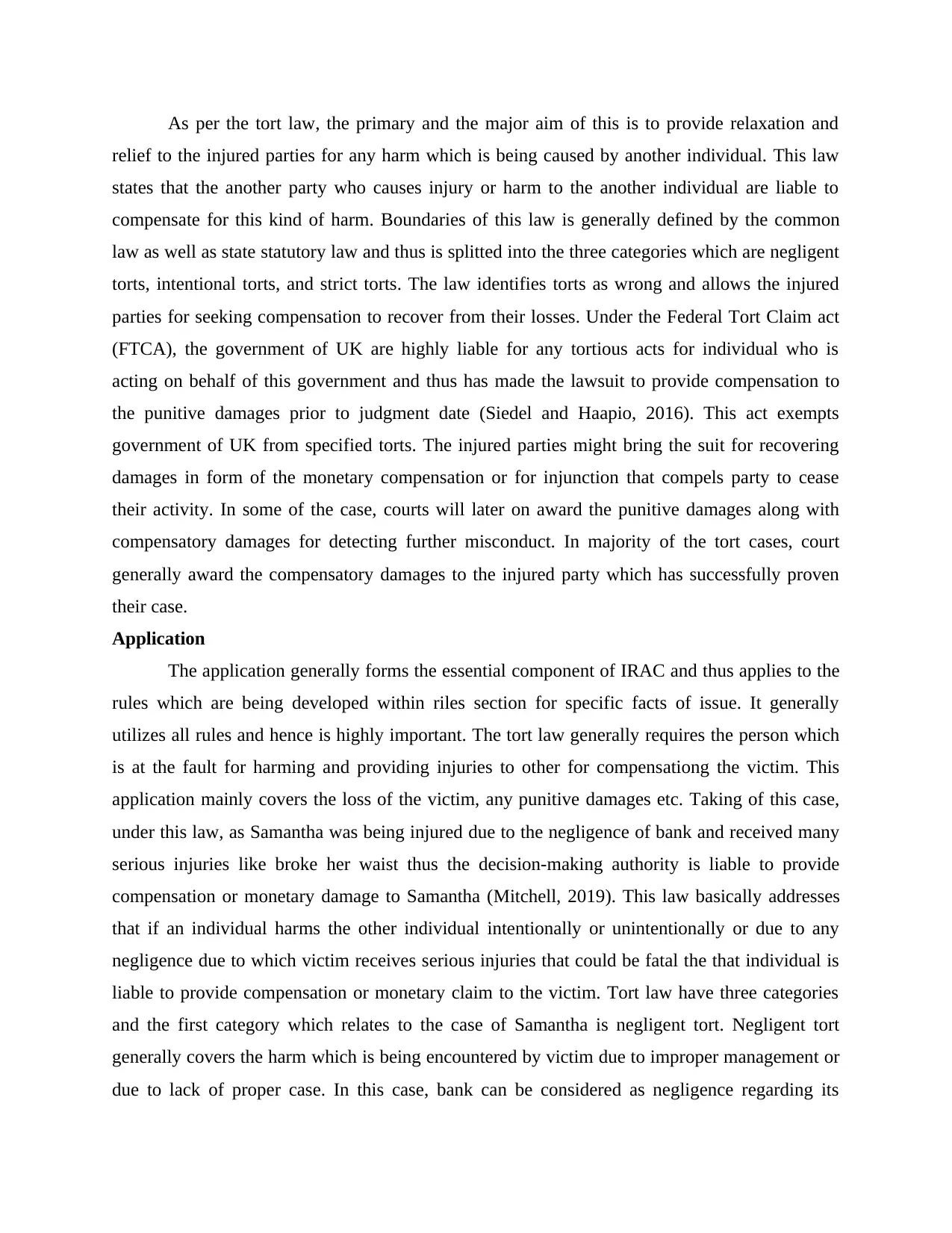
As per the tort law, the primary and the major aim of this is to provide relaxation and
relief to the injured parties for any harm which is being caused by another individual. This law
states that the another party who causes injury or harm to the another individual are liable to
compensate for this kind of harm. Boundaries of this law is generally defined by the common
law as well as state statutory law and thus is splitted into the three categories which are negligent
torts, intentional torts, and strict torts. The law identifies torts as wrong and allows the injured
parties for seeking compensation to recover from their losses. Under the Federal Tort Claim act
(FTCA), the government of UK are highly liable for any tortious acts for individual who is
acting on behalf of this government and thus has made the lawsuit to provide compensation to
the punitive damages prior to judgment date (Siedel and Haapio, 2016). This act exempts
government of UK from specified torts. The injured parties might bring the suit for recovering
damages in form of the monetary compensation or for injunction that compels party to cease
their activity. In some of the case, courts will later on award the punitive damages along with
compensatory damages for detecting further misconduct. In majority of the tort cases, court
generally award the compensatory damages to the injured party which has successfully proven
their case.
Application
The application generally forms the essential component of IRAC and thus applies to the
rules which are being developed within riles section for specific facts of issue. It generally
utilizes all rules and hence is highly important. The tort law generally requires the person which
is at the fault for harming and providing injuries to other for compensationg the victim. This
application mainly covers the loss of the victim, any punitive damages etc. Taking of this case,
under this law, as Samantha was being injured due to the negligence of bank and received many
serious injuries like broke her waist thus the decision-making authority is liable to provide
compensation or monetary damage to Samantha (Mitchell, 2019). This law basically addresses
that if an individual harms the other individual intentionally or unintentionally or due to any
negligence due to which victim receives serious injuries that could be fatal the that individual is
liable to provide compensation or monetary claim to the victim. Tort law have three categories
and the first category which relates to the case of Samantha is negligent tort. Negligent tort
generally covers the harm which is being encountered by victim due to improper management or
due to lack of proper case. In this case, bank can be considered as negligence regarding its
relief to the injured parties for any harm which is being caused by another individual. This law
states that the another party who causes injury or harm to the another individual are liable to
compensate for this kind of harm. Boundaries of this law is generally defined by the common
law as well as state statutory law and thus is splitted into the three categories which are negligent
torts, intentional torts, and strict torts. The law identifies torts as wrong and allows the injured
parties for seeking compensation to recover from their losses. Under the Federal Tort Claim act
(FTCA), the government of UK are highly liable for any tortious acts for individual who is
acting on behalf of this government and thus has made the lawsuit to provide compensation to
the punitive damages prior to judgment date (Siedel and Haapio, 2016). This act exempts
government of UK from specified torts. The injured parties might bring the suit for recovering
damages in form of the monetary compensation or for injunction that compels party to cease
their activity. In some of the case, courts will later on award the punitive damages along with
compensatory damages for detecting further misconduct. In majority of the tort cases, court
generally award the compensatory damages to the injured party which has successfully proven
their case.
Application
The application generally forms the essential component of IRAC and thus applies to the
rules which are being developed within riles section for specific facts of issue. It generally
utilizes all rules and hence is highly important. The tort law generally requires the person which
is at the fault for harming and providing injuries to other for compensationg the victim. This
application mainly covers the loss of the victim, any punitive damages etc. Taking of this case,
under this law, as Samantha was being injured due to the negligence of bank and received many
serious injuries like broke her waist thus the decision-making authority is liable to provide
compensation or monetary damage to Samantha (Mitchell, 2019). This law basically addresses
that if an individual harms the other individual intentionally or unintentionally or due to any
negligence due to which victim receives serious injuries that could be fatal the that individual is
liable to provide compensation or monetary claim to the victim. Tort law have three categories
and the first category which relates to the case of Samantha is negligent tort. Negligent tort
generally covers the harm which is being encountered by victim due to improper management or
due to lack of proper case. In this case, bank can be considered as negligence regarding its
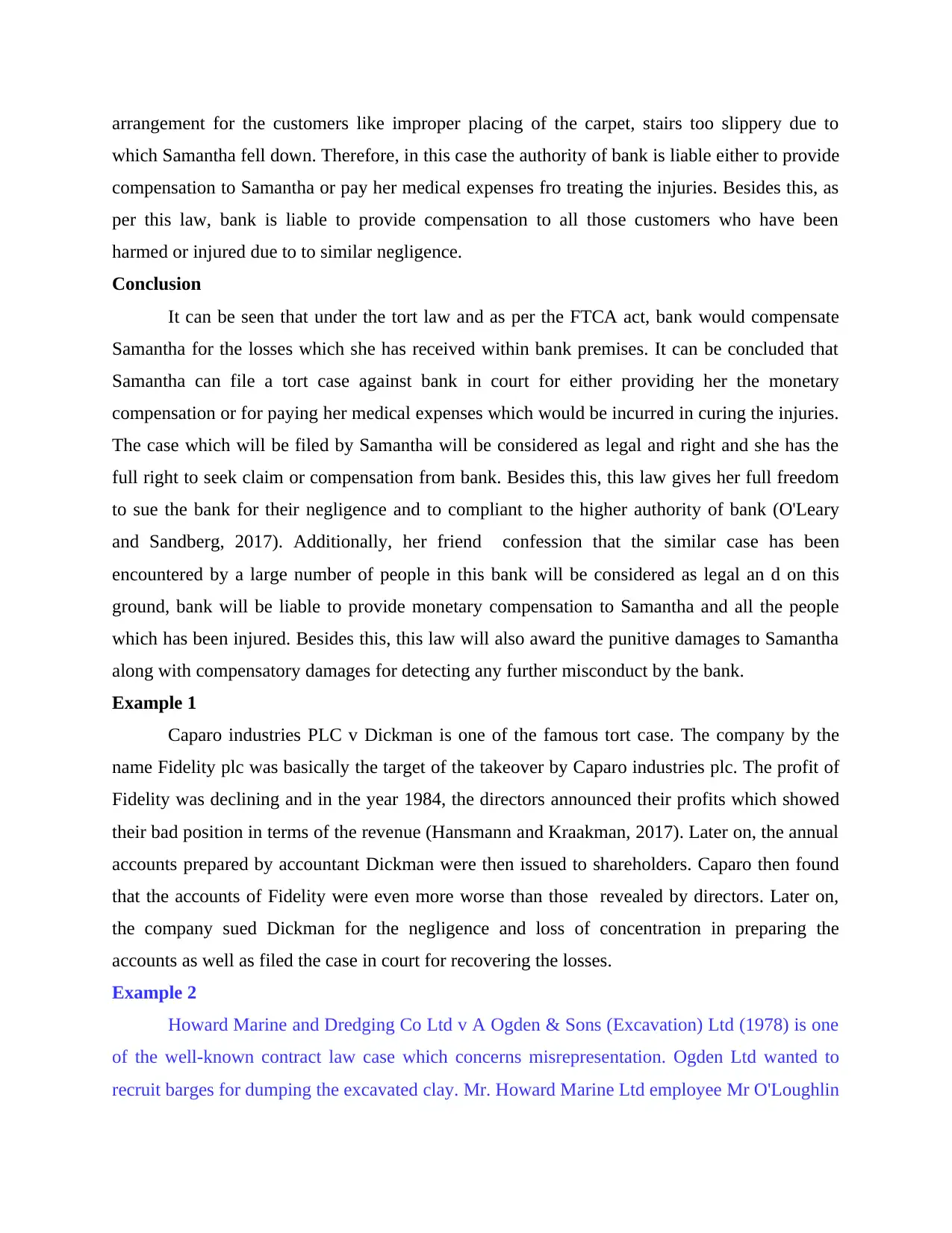
arrangement for the customers like improper placing of the carpet, stairs too slippery due to
which Samantha fell down. Therefore, in this case the authority of bank is liable either to provide
compensation to Samantha or pay her medical expenses fro treating the injuries. Besides this, as
per this law, bank is liable to provide compensation to all those customers who have been
harmed or injured due to to similar negligence.
Conclusion
It can be seen that under the tort law and as per the FTCA act, bank would compensate
Samantha for the losses which she has received within bank premises. It can be concluded that
Samantha can file a tort case against bank in court for either providing her the monetary
compensation or for paying her medical expenses which would be incurred in curing the injuries.
The case which will be filed by Samantha will be considered as legal and right and she has the
full right to seek claim or compensation from bank. Besides this, this law gives her full freedom
to sue the bank for their negligence and to compliant to the higher authority of bank (O'Leary
and Sandberg, 2017). Additionally, her friend confession that the similar case has been
encountered by a large number of people in this bank will be considered as legal an d on this
ground, bank will be liable to provide monetary compensation to Samantha and all the people
which has been injured. Besides this, this law will also award the punitive damages to Samantha
along with compensatory damages for detecting any further misconduct by the bank.
Example 1
Caparo industries PLC v Dickman is one of the famous tort case. The company by the
name Fidelity plc was basically the target of the takeover by Caparo industries plc. The profit of
Fidelity was declining and in the year 1984, the directors announced their profits which showed
their bad position in terms of the revenue (Hansmann and Kraakman, 2017). Later on, the annual
accounts prepared by accountant Dickman were then issued to shareholders. Caparo then found
that the accounts of Fidelity were even more worse than those revealed by directors. Later on,
the company sued Dickman for the negligence and loss of concentration in preparing the
accounts as well as filed the case in court for recovering the losses.
Example 2
Howard Marine and Dredging Co Ltd v A Ogden & Sons (Excavation) Ltd (1978) is one
of the well-known contract law case which concerns misrepresentation. Ogden Ltd wanted to
recruit barges for dumping the excavated clay. Mr. Howard Marine Ltd employee Mr O'Loughlin
which Samantha fell down. Therefore, in this case the authority of bank is liable either to provide
compensation to Samantha or pay her medical expenses fro treating the injuries. Besides this, as
per this law, bank is liable to provide compensation to all those customers who have been
harmed or injured due to to similar negligence.
Conclusion
It can be seen that under the tort law and as per the FTCA act, bank would compensate
Samantha for the losses which she has received within bank premises. It can be concluded that
Samantha can file a tort case against bank in court for either providing her the monetary
compensation or for paying her medical expenses which would be incurred in curing the injuries.
The case which will be filed by Samantha will be considered as legal and right and she has the
full right to seek claim or compensation from bank. Besides this, this law gives her full freedom
to sue the bank for their negligence and to compliant to the higher authority of bank (O'Leary
and Sandberg, 2017). Additionally, her friend confession that the similar case has been
encountered by a large number of people in this bank will be considered as legal an d on this
ground, bank will be liable to provide monetary compensation to Samantha and all the people
which has been injured. Besides this, this law will also award the punitive damages to Samantha
along with compensatory damages for detecting any further misconduct by the bank.
Example 1
Caparo industries PLC v Dickman is one of the famous tort case. The company by the
name Fidelity plc was basically the target of the takeover by Caparo industries plc. The profit of
Fidelity was declining and in the year 1984, the directors announced their profits which showed
their bad position in terms of the revenue (Hansmann and Kraakman, 2017). Later on, the annual
accounts prepared by accountant Dickman were then issued to shareholders. Caparo then found
that the accounts of Fidelity were even more worse than those revealed by directors. Later on,
the company sued Dickman for the negligence and loss of concentration in preparing the
accounts as well as filed the case in court for recovering the losses.
Example 2
Howard Marine and Dredging Co Ltd v A Ogden & Sons (Excavation) Ltd (1978) is one
of the well-known contract law case which concerns misrepresentation. Ogden Ltd wanted to
recruit barges for dumping the excavated clay. Mr. Howard Marine Ltd employee Mr O'Loughlin
Paraphrase This Document
Need a fresh take? Get an instant paraphrase of this document with our AI Paraphraser
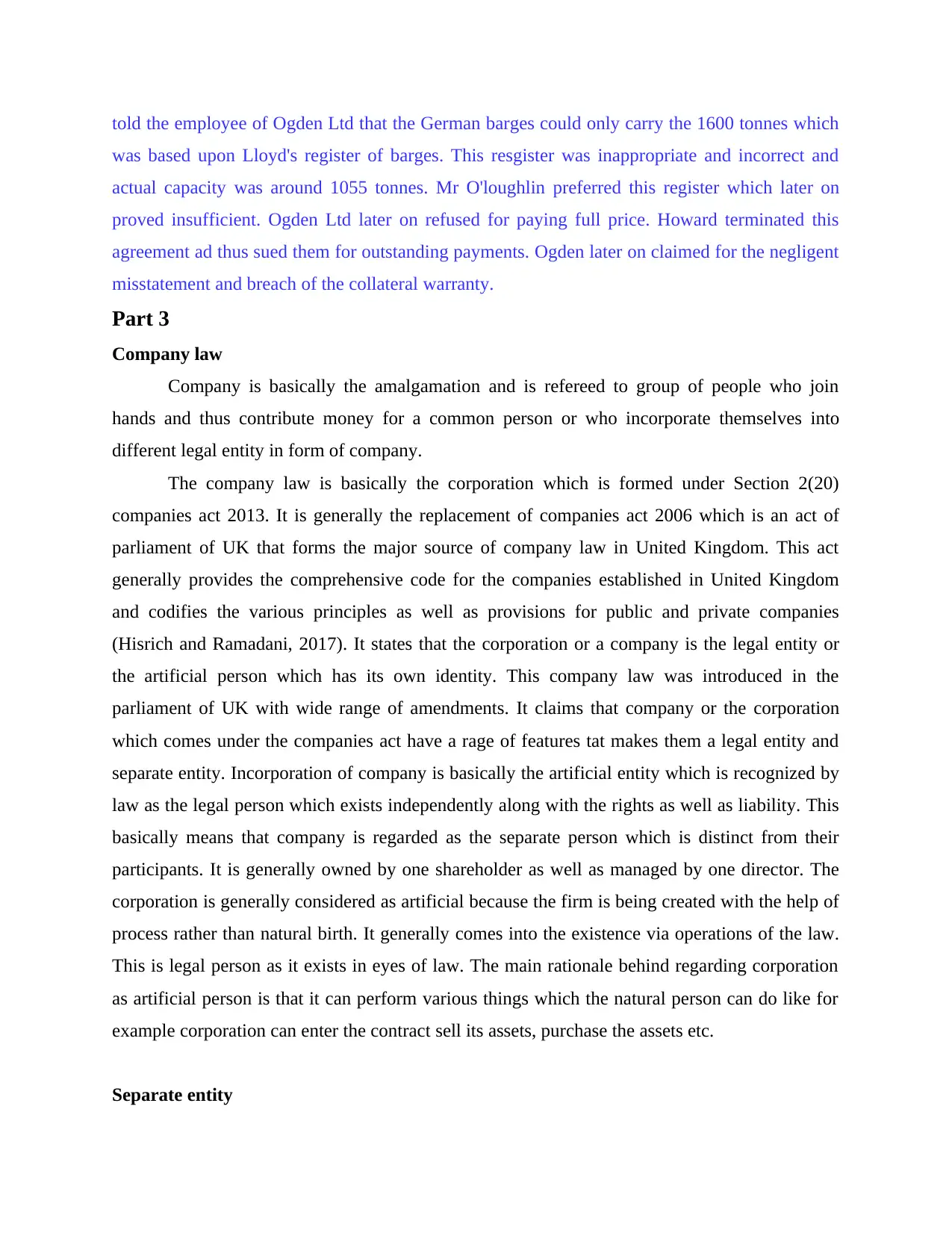
told the employee of Ogden Ltd that the German barges could only carry the 1600 tonnes which
was based upon Lloyd's register of barges. This resgister was inappropriate and incorrect and
actual capacity was around 1055 tonnes. Mr O'loughlin preferred this register which later on
proved insufficient. Ogden Ltd later on refused for paying full price. Howard terminated this
agreement ad thus sued them for outstanding payments. Ogden later on claimed for the negligent
misstatement and breach of the collateral warranty.
Part 3
Company law
Company is basically the amalgamation and is refereed to group of people who join
hands and thus contribute money for a common person or who incorporate themselves into
different legal entity in form of company.
The company law is basically the corporation which is formed under Section 2(20)
companies act 2013. It is generally the replacement of companies act 2006 which is an act of
parliament of UK that forms the major source of company law in United Kingdom. This act
generally provides the comprehensive code for the companies established in United Kingdom
and codifies the various principles as well as provisions for public and private companies
(Hisrich and Ramadani, 2017). It states that the corporation or a company is the legal entity or
the artificial person which has its own identity. This company law was introduced in the
parliament of UK with wide range of amendments. It claims that company or the corporation
which comes under the companies act have a rage of features tat makes them a legal entity and
separate entity. Incorporation of company is basically the artificial entity which is recognized by
law as the legal person which exists independently along with the rights as well as liability. This
basically means that company is regarded as the separate person which is distinct from their
participants. It is generally owned by one shareholder as well as managed by one director. The
corporation is generally considered as artificial because the firm is being created with the help of
process rather than natural birth. It generally comes into the existence via operations of the law.
This is legal person as it exists in eyes of law. The main rationale behind regarding corporation
as artificial person is that it can perform various things which the natural person can do like for
example corporation can enter the contract sell its assets, purchase the assets etc.
Separate entity
was based upon Lloyd's register of barges. This resgister was inappropriate and incorrect and
actual capacity was around 1055 tonnes. Mr O'loughlin preferred this register which later on
proved insufficient. Ogden Ltd later on refused for paying full price. Howard terminated this
agreement ad thus sued them for outstanding payments. Ogden later on claimed for the negligent
misstatement and breach of the collateral warranty.
Part 3
Company law
Company is basically the amalgamation and is refereed to group of people who join
hands and thus contribute money for a common person or who incorporate themselves into
different legal entity in form of company.
The company law is basically the corporation which is formed under Section 2(20)
companies act 2013. It is generally the replacement of companies act 2006 which is an act of
parliament of UK that forms the major source of company law in United Kingdom. This act
generally provides the comprehensive code for the companies established in United Kingdom
and codifies the various principles as well as provisions for public and private companies
(Hisrich and Ramadani, 2017). It states that the corporation or a company is the legal entity or
the artificial person which has its own identity. This company law was introduced in the
parliament of UK with wide range of amendments. It claims that company or the corporation
which comes under the companies act have a rage of features tat makes them a legal entity and
separate entity. Incorporation of company is basically the artificial entity which is recognized by
law as the legal person which exists independently along with the rights as well as liability. This
basically means that company is regarded as the separate person which is distinct from their
participants. It is generally owned by one shareholder as well as managed by one director. The
corporation is generally considered as artificial because the firm is being created with the help of
process rather than natural birth. It generally comes into the existence via operations of the law.
This is legal person as it exists in eyes of law. The main rationale behind regarding corporation
as artificial person is that it can perform various things which the natural person can do like for
example corporation can enter the contract sell its assets, purchase the assets etc.
Separate entity
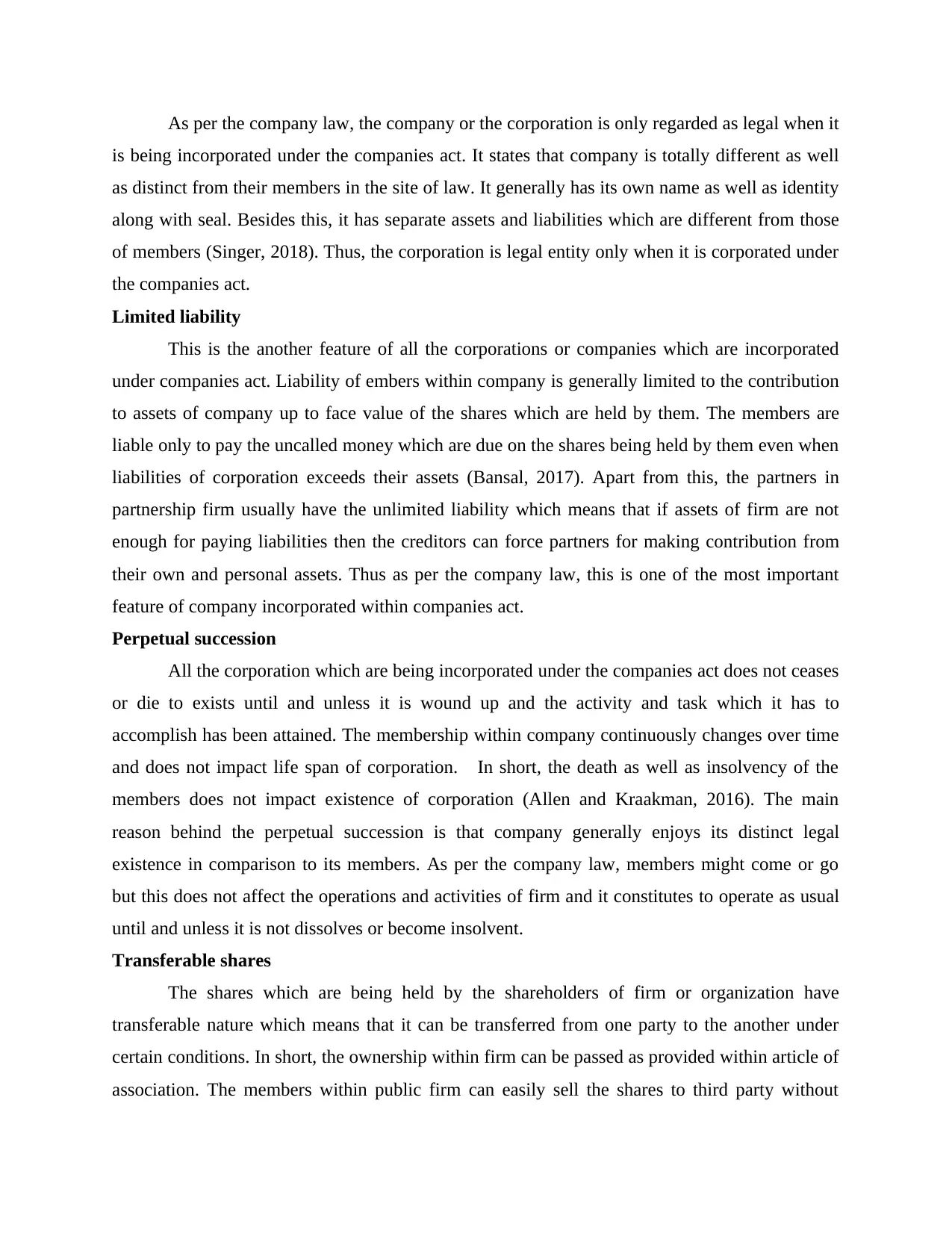
As per the company law, the company or the corporation is only regarded as legal when it
is being incorporated under the companies act. It states that company is totally different as well
as distinct from their members in the site of law. It generally has its own name as well as identity
along with seal. Besides this, it has separate assets and liabilities which are different from those
of members (Singer, 2018). Thus, the corporation is legal entity only when it is corporated under
the companies act.
Limited liability
This is the another feature of all the corporations or companies which are incorporated
under companies act. Liability of embers within company is generally limited to the contribution
to assets of company up to face value of the shares which are held by them. The members are
liable only to pay the uncalled money which are due on the shares being held by them even when
liabilities of corporation exceeds their assets (Bansal, 2017). Apart from this, the partners in
partnership firm usually have the unlimited liability which means that if assets of firm are not
enough for paying liabilities then the creditors can force partners for making contribution from
their own and personal assets. Thus as per the company law, this is one of the most important
feature of company incorporated within companies act.
Perpetual succession
All the corporation which are being incorporated under the companies act does not ceases
or die to exists until and unless it is wound up and the activity and task which it has to
accomplish has been attained. The membership within company continuously changes over time
and does not impact life span of corporation. In short, the death as well as insolvency of the
members does not impact existence of corporation (Allen and Kraakman, 2016). The main
reason behind the perpetual succession is that company generally enjoys its distinct legal
existence in comparison to its members. As per the company law, members might come or go
but this does not affect the operations and activities of firm and it constitutes to operate as usual
until and unless it is not dissolves or become insolvent.
Transferable shares
The shares which are being held by the shareholders of firm or organization have
transferable nature which means that it can be transferred from one party to the another under
certain conditions. In short, the ownership within firm can be passed as provided within article of
association. The members within public firm can easily sell the shares to third party without
is being incorporated under the companies act. It states that company is totally different as well
as distinct from their members in the site of law. It generally has its own name as well as identity
along with seal. Besides this, it has separate assets and liabilities which are different from those
of members (Singer, 2018). Thus, the corporation is legal entity only when it is corporated under
the companies act.
Limited liability
This is the another feature of all the corporations or companies which are incorporated
under companies act. Liability of embers within company is generally limited to the contribution
to assets of company up to face value of the shares which are held by them. The members are
liable only to pay the uncalled money which are due on the shares being held by them even when
liabilities of corporation exceeds their assets (Bansal, 2017). Apart from this, the partners in
partnership firm usually have the unlimited liability which means that if assets of firm are not
enough for paying liabilities then the creditors can force partners for making contribution from
their own and personal assets. Thus as per the company law, this is one of the most important
feature of company incorporated within companies act.
Perpetual succession
All the corporation which are being incorporated under the companies act does not ceases
or die to exists until and unless it is wound up and the activity and task which it has to
accomplish has been attained. The membership within company continuously changes over time
and does not impact life span of corporation. In short, the death as well as insolvency of the
members does not impact existence of corporation (Allen and Kraakman, 2016). The main
reason behind the perpetual succession is that company generally enjoys its distinct legal
existence in comparison to its members. As per the company law, members might come or go
but this does not affect the operations and activities of firm and it constitutes to operate as usual
until and unless it is not dissolves or become insolvent.
Transferable shares
The shares which are being held by the shareholders of firm or organization have
transferable nature which means that it can be transferred from one party to the another under
certain conditions. In short, the ownership within firm can be passed as provided within article of
association. The members within public firm can easily sell the shares to third party without
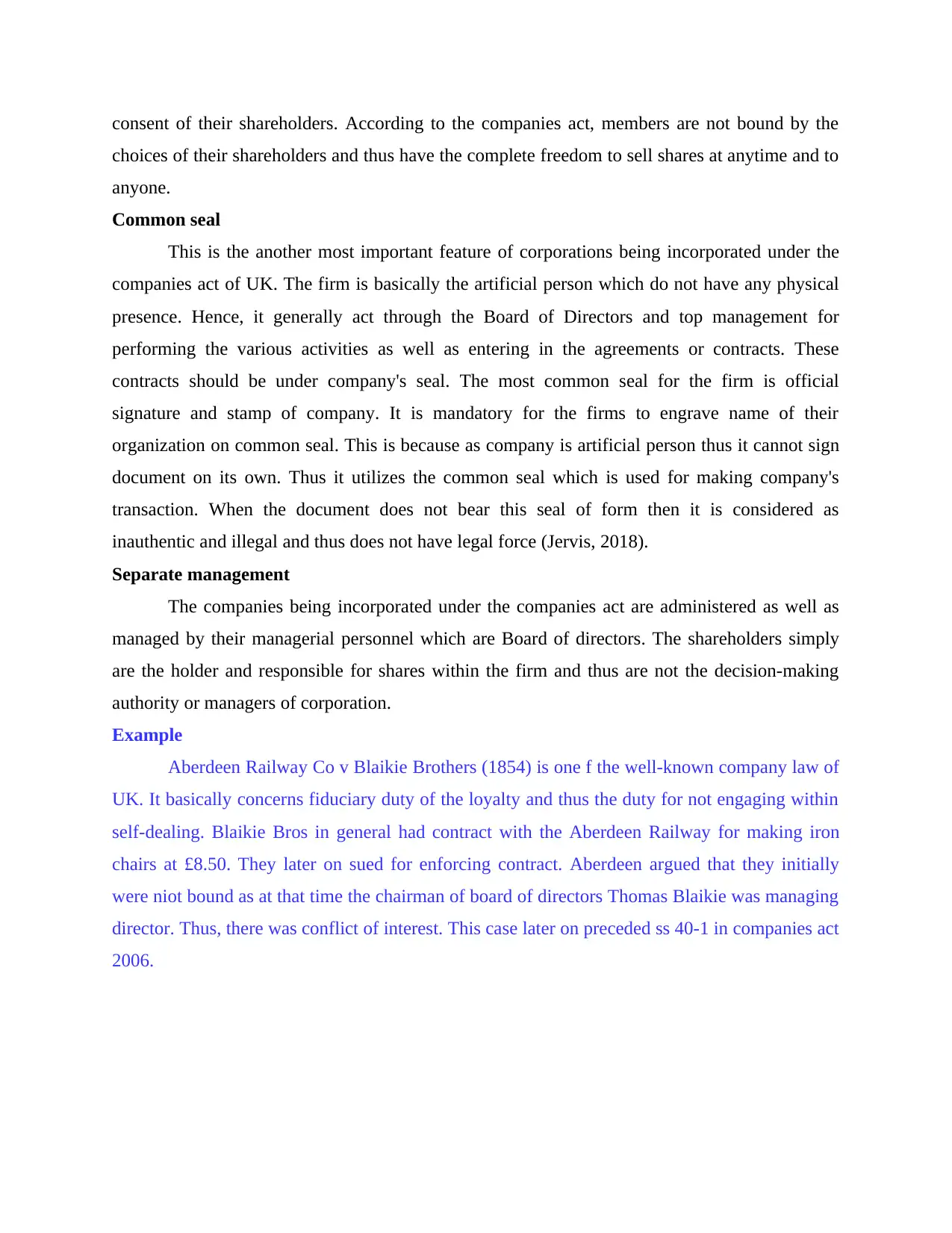
consent of their shareholders. According to the companies act, members are not bound by the
choices of their shareholders and thus have the complete freedom to sell shares at anytime and to
anyone.
Common seal
This is the another most important feature of corporations being incorporated under the
companies act of UK. The firm is basically the artificial person which do not have any physical
presence. Hence, it generally act through the Board of Directors and top management for
performing the various activities as well as entering in the agreements or contracts. These
contracts should be under company's seal. The most common seal for the firm is official
signature and stamp of company. It is mandatory for the firms to engrave name of their
organization on common seal. This is because as company is artificial person thus it cannot sign
document on its own. Thus it utilizes the common seal which is used for making company's
transaction. When the document does not bear this seal of form then it is considered as
inauthentic and illegal and thus does not have legal force (Jervis, 2018).
Separate management
The companies being incorporated under the companies act are administered as well as
managed by their managerial personnel which are Board of directors. The shareholders simply
are the holder and responsible for shares within the firm and thus are not the decision-making
authority or managers of corporation.
Example
Aberdeen Railway Co v Blaikie Brothers (1854) is one f the well-known company law of
UK. It basically concerns fiduciary duty of the loyalty and thus the duty for not engaging within
self-dealing. Blaikie Bros in general had contract with the Aberdeen Railway for making iron
chairs at £8.50. They later on sued for enforcing contract. Aberdeen argued that they initially
were niot bound as at that time the chairman of board of directors Thomas Blaikie was managing
director. Thus, there was conflict of interest. This case later on preceded ss 40-1 in companies act
2006.
choices of their shareholders and thus have the complete freedom to sell shares at anytime and to
anyone.
Common seal
This is the another most important feature of corporations being incorporated under the
companies act of UK. The firm is basically the artificial person which do not have any physical
presence. Hence, it generally act through the Board of Directors and top management for
performing the various activities as well as entering in the agreements or contracts. These
contracts should be under company's seal. The most common seal for the firm is official
signature and stamp of company. It is mandatory for the firms to engrave name of their
organization on common seal. This is because as company is artificial person thus it cannot sign
document on its own. Thus it utilizes the common seal which is used for making company's
transaction. When the document does not bear this seal of form then it is considered as
inauthentic and illegal and thus does not have legal force (Jervis, 2018).
Separate management
The companies being incorporated under the companies act are administered as well as
managed by their managerial personnel which are Board of directors. The shareholders simply
are the holder and responsible for shares within the firm and thus are not the decision-making
authority or managers of corporation.
Example
Aberdeen Railway Co v Blaikie Brothers (1854) is one f the well-known company law of
UK. It basically concerns fiduciary duty of the loyalty and thus the duty for not engaging within
self-dealing. Blaikie Bros in general had contract with the Aberdeen Railway for making iron
chairs at £8.50. They later on sued for enforcing contract. Aberdeen argued that they initially
were niot bound as at that time the chairman of board of directors Thomas Blaikie was managing
director. Thus, there was conflict of interest. This case later on preceded ss 40-1 in companies act
2006.
Secure Best Marks with AI Grader
Need help grading? Try our AI Grader for instant feedback on your assignments.
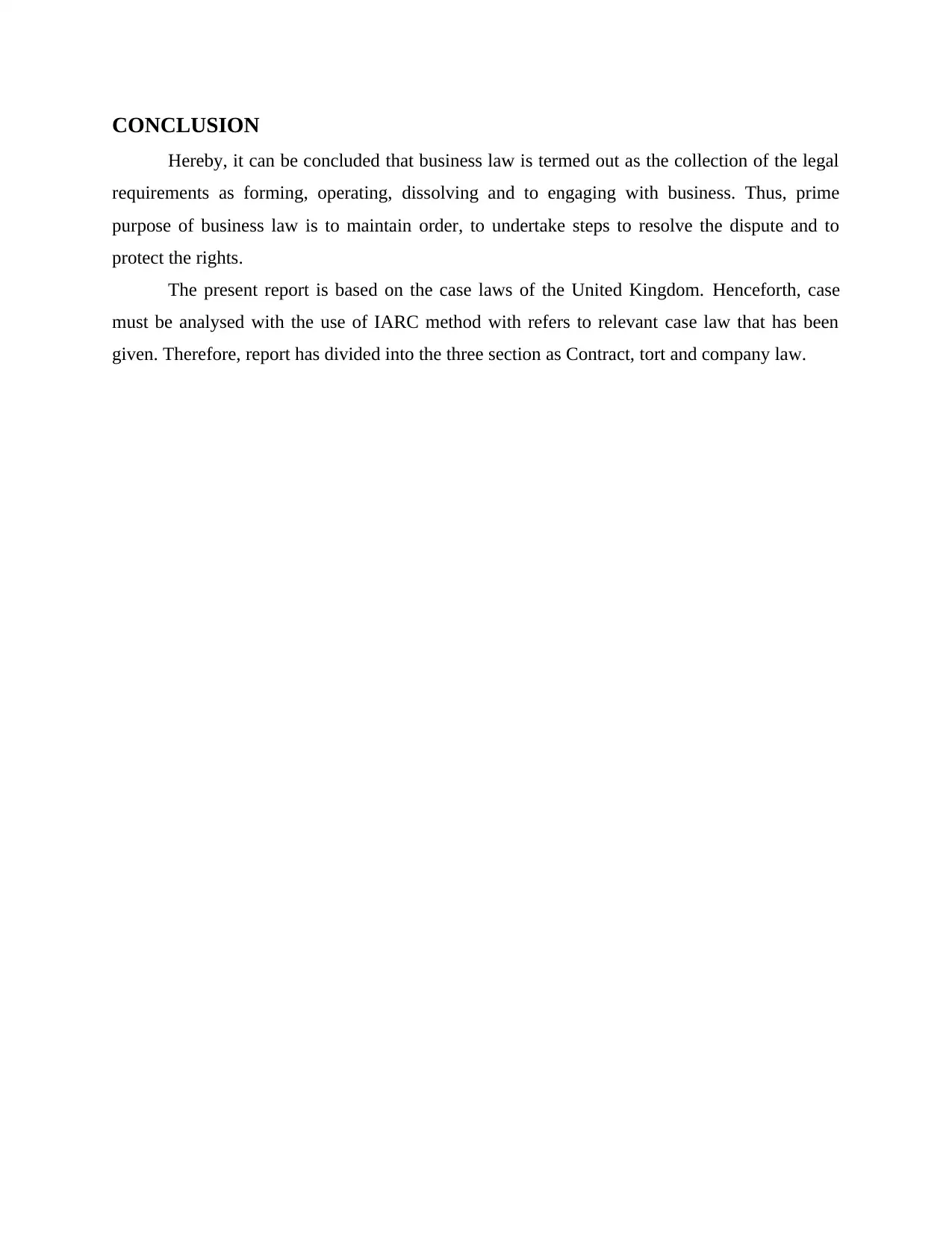
CONCLUSION
Hereby, it can be concluded that business law is termed out as the collection of the legal
requirements as forming, operating, dissolving and to engaging with business. Thus, prime
purpose of business law is to maintain order, to undertake steps to resolve the dispute and to
protect the rights.
The present report is based on the case laws of the United Kingdom. Henceforth, case
must be analysed with the use of IARC method with refers to relevant case law that has been
given. Therefore, report has divided into the three section as Contract, tort and company law.
Hereby, it can be concluded that business law is termed out as the collection of the legal
requirements as forming, operating, dissolving and to engaging with business. Thus, prime
purpose of business law is to maintain order, to undertake steps to resolve the dispute and to
protect the rights.
The present report is based on the case laws of the United Kingdom. Henceforth, case
must be analysed with the use of IARC method with refers to relevant case law that has been
given. Therefore, report has divided into the three section as Contract, tort and company law.
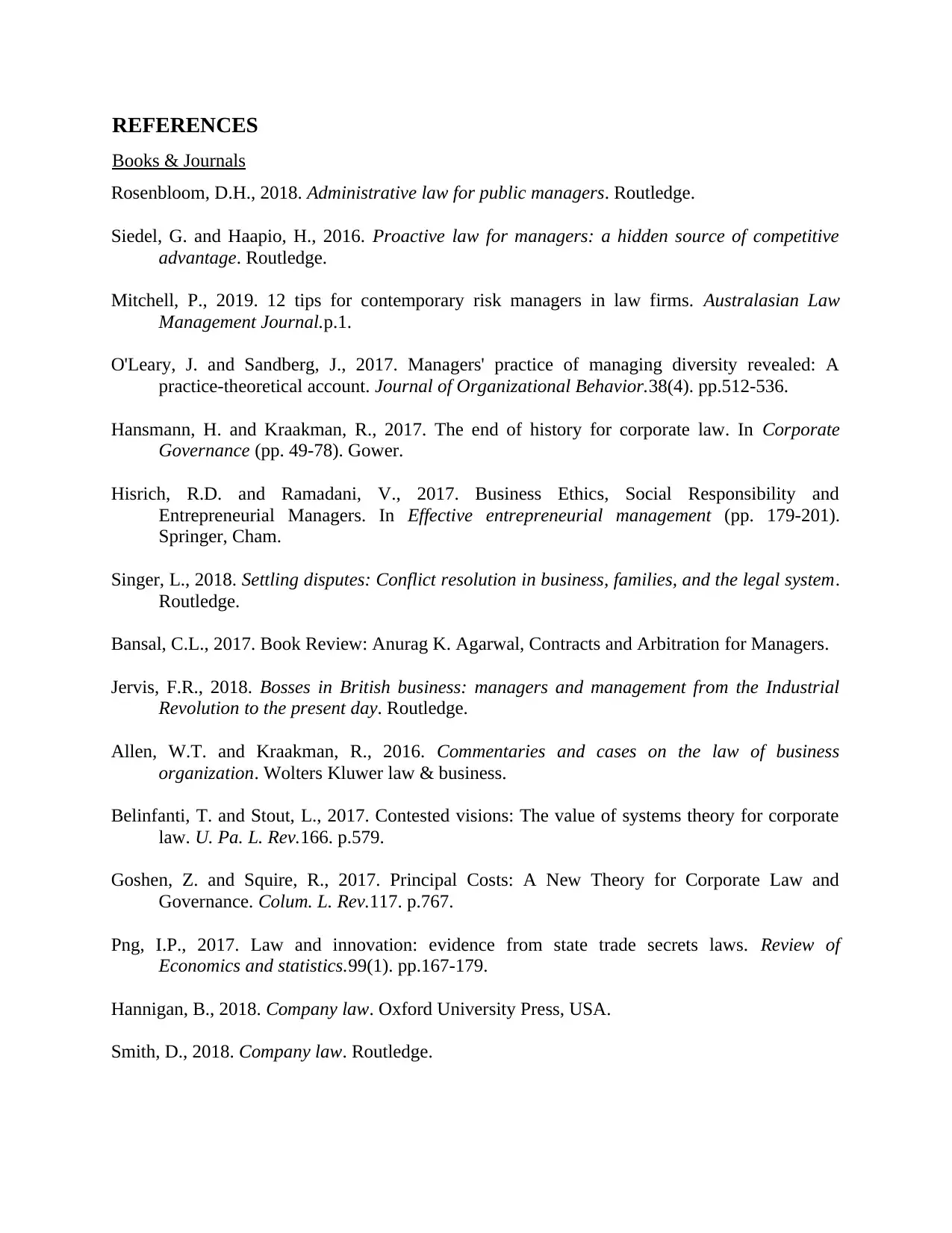
REFERENCES
Books & Journals
Rosenbloom, D.H., 2018. Administrative law for public managers. Routledge.
Siedel, G. and Haapio, H., 2016. Proactive law for managers: a hidden source of competitive
advantage. Routledge.
Mitchell, P., 2019. 12 tips for contemporary risk managers in law firms. Australasian Law
Management Journal.p.1.
O'Leary, J. and Sandberg, J., 2017. Managers' practice of managing diversity revealed: A
practice‐theoretical account. Journal of Organizational Behavior.38(4). pp.512-536.
Hansmann, H. and Kraakman, R., 2017. The end of history for corporate law. In Corporate
Governance (pp. 49-78). Gower.
Hisrich, R.D. and Ramadani, V., 2017. Business Ethics, Social Responsibility and
Entrepreneurial Managers. In Effective entrepreneurial management (pp. 179-201).
Springer, Cham.
Singer, L., 2018. Settling disputes: Conflict resolution in business, families, and the legal system.
Routledge.
Bansal, C.L., 2017. Book Review: Anurag K. Agarwal, Contracts and Arbitration for Managers.
Jervis, F.R., 2018. Bosses in British business: managers and management from the Industrial
Revolution to the present day. Routledge.
Allen, W.T. and Kraakman, R., 2016. Commentaries and cases on the law of business
organization. Wolters Kluwer law & business.
Belinfanti, T. and Stout, L., 2017. Contested visions: The value of systems theory for corporate
law. U. Pa. L. Rev.166. p.579.
Goshen, Z. and Squire, R., 2017. Principal Costs: A New Theory for Corporate Law and
Governance. Colum. L. Rev.117. p.767.
Png, I.P., 2017. Law and innovation: evidence from state trade secrets laws. Review of
Economics and statistics.99(1). pp.167-179.
Hannigan, B., 2018. Company law. Oxford University Press, USA.
Smith, D., 2018. Company law. Routledge.
Books & Journals
Rosenbloom, D.H., 2018. Administrative law for public managers. Routledge.
Siedel, G. and Haapio, H., 2016. Proactive law for managers: a hidden source of competitive
advantage. Routledge.
Mitchell, P., 2019. 12 tips for contemporary risk managers in law firms. Australasian Law
Management Journal.p.1.
O'Leary, J. and Sandberg, J., 2017. Managers' practice of managing diversity revealed: A
practice‐theoretical account. Journal of Organizational Behavior.38(4). pp.512-536.
Hansmann, H. and Kraakman, R., 2017. The end of history for corporate law. In Corporate
Governance (pp. 49-78). Gower.
Hisrich, R.D. and Ramadani, V., 2017. Business Ethics, Social Responsibility and
Entrepreneurial Managers. In Effective entrepreneurial management (pp. 179-201).
Springer, Cham.
Singer, L., 2018. Settling disputes: Conflict resolution in business, families, and the legal system.
Routledge.
Bansal, C.L., 2017. Book Review: Anurag K. Agarwal, Contracts and Arbitration for Managers.
Jervis, F.R., 2018. Bosses in British business: managers and management from the Industrial
Revolution to the present day. Routledge.
Allen, W.T. and Kraakman, R., 2016. Commentaries and cases on the law of business
organization. Wolters Kluwer law & business.
Belinfanti, T. and Stout, L., 2017. Contested visions: The value of systems theory for corporate
law. U. Pa. L. Rev.166. p.579.
Goshen, Z. and Squire, R., 2017. Principal Costs: A New Theory for Corporate Law and
Governance. Colum. L. Rev.117. p.767.
Png, I.P., 2017. Law and innovation: evidence from state trade secrets laws. Review of
Economics and statistics.99(1). pp.167-179.
Hannigan, B., 2018. Company law. Oxford University Press, USA.
Smith, D., 2018. Company law. Routledge.

Belinfanti and Stout, 2017 Goshen and Squire, 2017 Png, 2017 Smith, 2018. Hannigan, 2018
1 out of 13
Related Documents
Your All-in-One AI-Powered Toolkit for Academic Success.
+13062052269
info@desklib.com
Available 24*7 on WhatsApp / Email
![[object Object]](/_next/static/media/star-bottom.7253800d.svg)
Unlock your academic potential
© 2024 | Zucol Services PVT LTD | All rights reserved.





